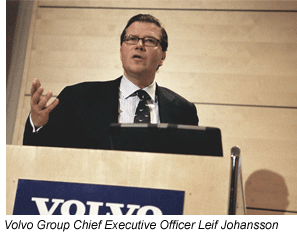European commercial vehicle manufacturers jointly develop evaluation tool to help further reduce CO2 emissions
September 27, 2010
 ACEA, the European Automobile Manufacturers’ Association based in Brussels, Belgium, has reported that European commercial vehicle manufacturers are developing an evaluation tool to calculate real-life emissions from trucks and buses ahead of purchase. Market forces play an instrumental role in reducing CO2 emissions from road transport and an accurate CO2-calculator would further support the customer in the most fuel-efficient vehicle for each specific transport. The initiative marks an important step in realising the commercial vehicle industry’s ‘Vision 2020’, announced in Hanover in 2008, pledging to further reduce CO2 emissions by 20% by 2020 (compared to 2005).
ACEA, the European Automobile Manufacturers’ Association based in Brussels, Belgium, has reported that European commercial vehicle manufacturers are developing an evaluation tool to calculate real-life emissions from trucks and buses ahead of purchase. Market forces play an instrumental role in reducing CO2 emissions from road transport and an accurate CO2-calculator would further support the customer in the most fuel-efficient vehicle for each specific transport. The initiative marks an important step in realising the commercial vehicle industry’s ‘Vision 2020’, announced in Hanover in 2008, pledging to further reduce CO2 emissions by 20% by 2020 (compared to 2005).
“Our industry fully supports the common objective to reduce CO2 emissions, and by sharing our expertise with the market as well as with policy makers, we will arrive at ambitious results”, said Leif Johansson, Chairman of the Commercial Vehicle Board of ACEA and President & CEO of Volvo Group, making a particular reference to the European Commission’s recently voiced intention to adopt policy measures to reduce CO2 from commercial vehicles.
“It is important that legislators support our efforts with a policy approach that matches the reality of commercial goods and passenger. Measures should, furthermore, be globally harmonised. Our industry operates globally, and climate change is also a global challenge.” Johansson stated in his address to reporters during the ACEA press conference at the international commercial vehicle show IAA in Hanover. He was accompanied by Harrie Schippers (DAF), Andreas Renschler (Daimler Trucks), Paolo Monferino (IVECO), Georg Pachta-Reyhofen (MAN) and Leif Östling (Scania). It was the second time that the ACEA commercial vehicle manufacturers’ executives have given a joint press conference.
Real-life tests with trucks and buses
CO2 emissions from commercial vehicle vary hugely depending on the vehicle’s ultimate size and shape and on the work it does, i.e. the load carried, the travelling distance and speed, the number of start-stops, and many more factors. Unlike for cars, the carbon dioxide emissions of trucks and buses cannot be simplified into an average tailpipe output defined in grams of CO2 per kilometre.
The calculation methodology promoted by ACEA uses computer simulation based on real-life tests with trucks and buses in a number of categories, ranging from city buses and garbage trucks, to delivery vehicles and long-haul transport. Emissions are calculated in grams of CO2 per tonne-kilometre, cubic metre-kilometre of goods or passenger-kilometre to properly reflect the purpose and usage of the vehicle concerned.
The CO2 evaluation tool will help customers to choose the most fuel-efficient vehicle specification, involving issues such as engine-gearbox combination, aerodynamic features and tyre specification. The tool will also serve to provide stakeholders-at-large with essential insight in the complexity and variety of road transport.
The commercial vehicle industry has already cut the fuel consumption of its products by more than a third since the 1970s. Pollutant emissions such as nitrogen oxides and particulate matter have already been reduced by as much as 85% and 95% respectively since the late 1980s.
Powder metallurgy is expected to play an important roll in the development of fuel efficient vehicles, particluary in energy storage and conversion systems such as batteries and fuel cells.
www.acea.be















